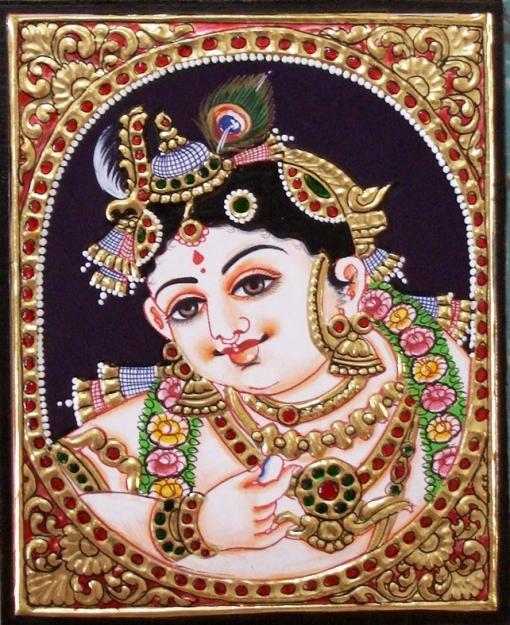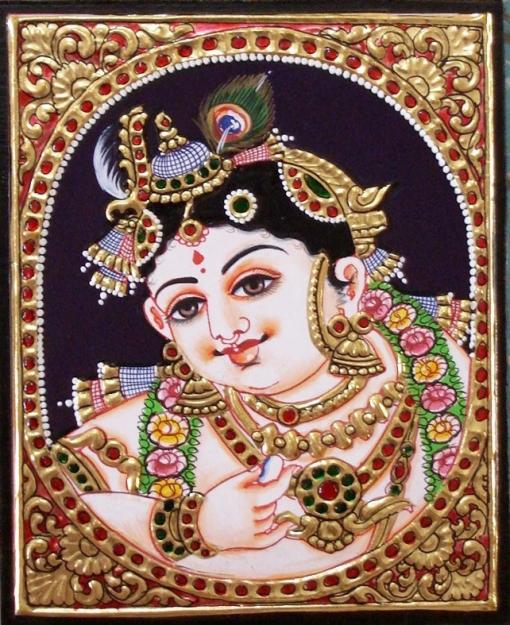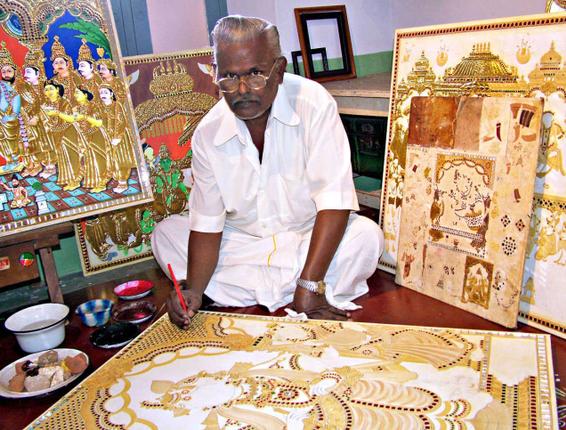
Tanjore Paintings on Fabric

Tanjore Painting Depicting Hindu Mythology (Image: http://www.sandhyamanne.com)
Tanjore Paintings are a form of art prevalent in Tamil Nadu and named after the town of Tanjore or Thanjavur. These paintings, although originally made on wooden planks and then on cloth canvas backed by a wooden frame, were adapted onto fabrics especially South Indian silk textiles. These are some of the richest, most luscious fabrics in South India. The paintings themselves have a very bold and rich look about them and when printed on fabric, create an outfit so grand, that it is fit solely for formal wear.
Background
In the 1600s, the inspiration for the Tanjore paintings came about in the Tanjore area under the suzerainty of the Vijayanagara Rayas. However, the modern forms of the Tanjore paintings are said to have originated in the Maratha court of Tanjore and was widely practiced between 1676 and 1855 AD. The artists who panted these works hailed from the Chitragar and Naidu communities.
In the 1800s, the Tanjore paintings were created to suit Western (specifically British) sensibilities; in that the motifs that were painted changed from religious to a mix of religious and secular
Sources of Inspiration
The inspiration for the Tanjore paintings was derived from the patronization of art forms such as classical dance, music, literature and paintings. The paintings, in particular, took the form of depiction of Hindu religious life i.e. gods, goddesses, episodes from religious texts such as the Puranas and even saints. In later years, the Tanjore paintings also included some depictions of Jain, Muslim, Sikh as well as secular subjects like fairs and festivals along with flora and fauna.
Whether on fabric or otherwise, the print has largely retained Hindu mythological motifs that, like the paintings, are bold. The body of the fabric features one main character at the center of the designated area while the corners are bedecked with peripheral characters from the episode. Like a lot of other paintings-turned-motifs, the Tanjore painting pattern is also huge in size and is not scaled down when being printed on fabric. The beauty of the fabrics printed with Tanjore painting motifs is their prominence on the body of the fabric.
Overall, there are three historical strains of influence on the Tanjore paintings viz. Deccan, Vijayanagara, and Martha, chronologically.
The Making
The original Tanjore paintings were made using powders of lime and tamarind seeds on cloth stretched over a wooden canvas. These paintings are high-relief and are characterized by flat yet rich and vivid colors and simple iconic composition. The other materials used to embellish or define the motifs were gold foil laid on extensive yet intricate gesso work and an inlay of beads made of glass as well as precious and semi-precious gems.

Tanjore Painting in the Process of Creation (Image: http://www.thehindu.com)
The broad process of creating a Tanjore painting involves:
- The wooden board is first softened using glue and emery sheets.
- The motifs are then sketched out onto the fabric pinned onto the board and these outlines are then finalized by sticking precious and semi-precious gems on these lines.
- The spaces around the gems are then filled with a thin layer of lime or tamarind powder mixed with gum or resin.
- Another thick layer of lime or tamarind powder is then used to create the relief and inlay work.
- The entire painting is then cleaned and refined.
- Next, gold foil is placed onto the stones and the relief work.
- The gold foil is then snipped and tidied to give a finished look to the painting.
Influence over the Ages
Tanjore paintings in their original form are a lost art that State and private agencies are constantly attempting to revive and restore. However, Tanjore paintings have influenced many forms of modern art such as C. Kondiah Raju’s calendar prints and Raja Ravi Varma’s Western naturalism.
Present Day Scenario
Tanjore paintings have been adapted onto some of the richest, most artsy looking sarees in the South. Making use of high-quality silk, these paintings have been ‘printed’ onto the fabric rather than painted. Since these sarees are meant for formal occasions and not festive occasions they cannot be decorated with gold foil or precious and semi-precious stones (or their substitutes). Instead, the same effects and appearance has been retained in the form of rich prints.
Innovations
In today’s day, it is impossible to use the rich materials that were originally used since that raises the cost of production immensely. Therefore, cost-effective substitutes such as plywood, synthetic colors and industrial adhesive are now being used.
Maintenance
Tanjore paintings in and of themselves need to preserved by framing them. The silk sarees with the Tanjore painting motifs on them however, need to be preserved like any other silk saree. It needs to be wrapped in Muslin along with naphthalene balls for protection against moths. It is preferable to dry clean them rather than wash them.
Facts and Trivia
- At its peak, Tanjore paintings made use of diamonds, sapphires, and rubies as embellishments.
- Tanjore paintings are often confused with Mysore Paintings as they share the same roots and makers. The difference however, lies in the materials being used and their relief work.
- Two of the major influences on this style of painting are said to be Kalamkari and Tirupati, under the Vijayanagara school.
References
Categories: Motifs & Embroideries
